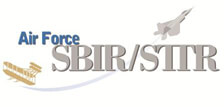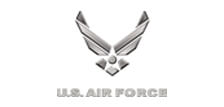Fastener Insertion Live Link System - FILLS
The revolutionary Fastener Insertion Live Link System, or FILLS, evolved from the IDRD and was spun off in a Phase III SBIR with a set of partners that included the Atlanta-area DeltaSigma Company. This time, instead of drilling holes, FILLS streamlined the arduous process of measuring and installing the myriad fasteners that go in those holes to attach aircraft skins to the underlying structure. Some 360 different types of fastener are used in F-35 construction, so matching thousands of holes with the correct fasteners is a major mechanical task.
The traditional process of matching fastener to hole was to manually count holes from the blueprint(literally, “hole number ten from the left: one, two, three. . .”) and mark the fastener type with a stickie note, masking tape, or felt marker. The mechanic would then write out an order to request the required fastener kit from supply. Instead, FILLS uses a projector to illuminate and annotate information and instructions directly on the air frame.
The optical projection system works in conjunction with a computer interface to guide the mechanic through fastener installation and other tasks, resulting in significantly improved efficiency and accuracy and creating a digital thread that carries from production through fielding and maintenance, repair, and overhaul.
“True to form,” says AFRL’s Pearl, “VRSI established a talented team of small businesses to lead the FILLS effort. The government’s $1.7 million investment in FILLS will yield over $111 million in cost avoidance savings for the F-35 alone—and the technology has been transitioned to numerous other programs as well.”
Transition and commercialization is taking off. Boeing integrated the SBIR-born technologies into its new Fuselage Automated Upright Build (FAUB) assembly process for 777 production, saving its workforce from the hand-numbing, shoulder-wrenching strain of “buckingrivets” day-in and day-out for that aircraft’s 60,000 fasteners. More than half of all injuries on the 777 program occur during the phase of production that will be automated. Six 777 fuselage shave been built using the FAUB system, with many more set to begin as additional infrastructure is put in place.
“The FAUB serves as something of a centerpiece for Boeing’s continuing evolution toward automotive-industry style automation,” writes Air Transport senior editor Gregory Polek. Aerospace called, Detroit answered, and VRSI took names.
The Air Force SBIR enabled the VRSI team to create and implement a linchpin solution for the Joint Strike Fighter, “and now we can leverage those technologies and our engineering expertise to help solve other manufacturing problems beyond the F-35,” Lowis says.
Even though she’d never heard of “sibbers” before, VRSI’s 2007 Phase I SBIR helped the company survive the recession that devastated Michigan’s manufacturing sector. Not only did VRSI survive, it’s thriving, having grown their aerospace group from three employees at the beginning of Phase I to ten today (overall, the company has grown from 22 to 57 employees in this this frame, including aerospace and automotive). Their success also translates into success for their end users as well as for partners like FARO, which has supplied 30 laser trackers for the Boeing system to date.
Fittingly, VRSI has been recognized with two Defense Manufacturing Technology Achievement Awards—the first team award in 2009 for the IDRD, and the second in 2012 for FILLS. In addition, VRSI took home a prestigious Tibbetts Award in 2011 for the company’s cumulative SBIR successes.
The squeeze was on in all ways when VRSI’s team showed up at the table with its industrial chops and Michigan-style tenacity. There were times Deborah Lowis put her head on her desk and wondered how they were going to pull it off. But with so much at stake, successwasn’t optional.
“It’s very gratifying,” Lowis says now of the overwhelming task and monumental accomplishment. “We had a strong core of people with a vested interest in seeing this work. And we did it.”
For any questions on the Video One Sheet, please email: info@mediamarketingconsultants.com
Back Home

